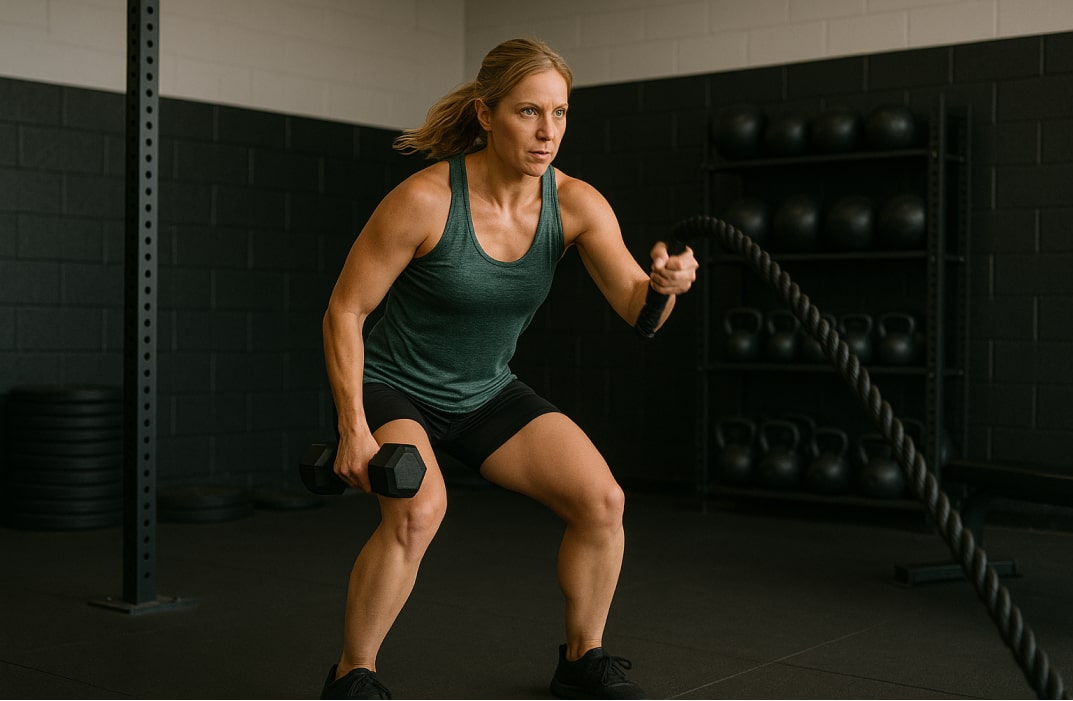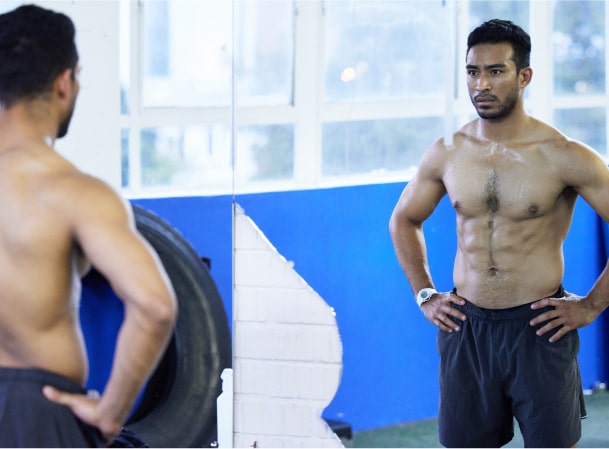When most people think about fitness, they picture lifting weights, running on a treadmill, or doing endless crunches. While these activities are part of the picture, strength and conditioning go far beyond just “working out.” It’s a structured approach to building strength and muscle, improving endurance, enhancing athletic performance, and supporting overall health.
In simple terms, strength and conditioning combines resistance training with cardiovascular, flexibility, and recovery strategies to help your body perform at its best—whether you’re an elite athlete, a weekend warrior, or someone just starting their fitness journey, taking into account your individual needs.
Consider this: an athlete may spend hours perfecting their sport skills, but without a solid strength and conditioning program, they risk injuries, muscle damage, fatigue, and plateaued performance. On the flip side, a well-rounded strength and conditioning workout ensures that muscles are stronger, joints are stable, endurance improves, and even mental resilience gets a boost.
By the end of this blog, you’ll understand:
- What strength and conditioning really means and how it differs from basic workouts
- The core principles that guide effective training programs
- The benefits you can gain, from muscle strength to improved sports performance
- How to start your own program safely and effectively
Whether your goal is to build muscle mass, improve athletic performance, or just maintain overall health, mastering strength and conditioning is the key to unlocking your full potential and reaping all the benefits .
What is Strength and Conditioning?

When you hear the terms strength and conditioning, you might wonder: “Isn’t this just lifting weights or running?” Not quite. Strength and conditioning is a holistic approach to training that combines shoulder-width muscle-strengthening exercises, cardiovascular conditioning, and mobility work to improve overall performance, prevent injuries, and enhance your body’s efficiency.
At its core, strength training focuses on building muscle strength and muscle mass through resistance exercises like lifting weights, bodyweight movements, or using resistance bands. Meanwhile, conditioning targets endurance, speed, agility, and cardiovascular fitness, helping your body sustain high-intensity activity over longer periods. When combined, these two elements create a balanced training program that supports athletes, fitness enthusiasts, and anyone looking to improve physical activity performance.
Strength vs. Conditioning: Understanding the Difference
Many people think strength conditioning only applies to athletes—but that’s a misconception. Even if your goal isn’t professional sports, a crucial strength and conditioning workout plan can improve posture, muscle hypertrophy, bone health, and overall well-being.
As legendary coach Charles Poliquin once said:
“Strength and conditioning isn’t just about lifting heavy; it’s about creating a resilient, powerful, and adaptable body.”
By integrating both elements into your routine, you’re not just building stronger muscles—you’re creating a foundation for long-term health, performance, and injury prevention.
Principles of Strength and Conditioning

Building a strong, conditioned body doesn’t happen by chance. It requires following key principles of strength and conditioning that ensure your workouts are effective, safe, and sustainable. Understanding these principles can make a huge difference in achieving your strength training, muscle hypertrophy, and athletic performance goals.
Here are the five core principles:
1. Specificity
Training should match your individual goals. If you’re a sprinter, your program should emphasize speed, agility, and explosive power. If you want to build muscle mass or core stability, your focus should be on resistance training and movement patterns that target those muscles, including the shoulder blades.
2. Progressive Overload
To keep making gains, you need to gradually increase the intensity of your workouts. This could mean lifting heavier weights, adding more repetitions, or increasing the speed of your conditioning drills. Over time, this ensures muscle tissue adapts, grows, and strengthens.
3. Recovery
Your muscles don’t grow while you train—they grow while you rest. Adequate sleep, nutrition, and recovery days are crucial to prevent fatigue, reduce the risk of injuries, and support muscle hypertrophy.
4. Variation
Your body adapts quickly to repetitive exercises. To avoid plateaus, change your workouts regularly. Swap exercises, alter rep ranges, or try different types of conditioning drills. This keeps training effective and engaging.
5. Individualization
No two bodies are the same. Your training program should reflect your fitness level, goals, and physical activity limitations. Beginners will require a different approach compared to advanced athletes, and everyone’s strength and conditioning workout should be tailored to their needs.
By following these principles, your strength and conditioning training becomes more effective, safer, and aligned with your performance goals. Remember, these aren’t just rules for athletes—they apply to anyone seeking better fitness, more muscle, coordination, and overall health benefits.
Components of Strength and Conditioning
A well-rounded strength and conditioning program doesn’t rely on just one type of exercise. To truly improve athletic performance, muscle strength, and overall fitness, your conditioning training should include multiple components that work together. Here are the key elements:
1. Resistance Training
Resistance training focuses on building muscle mass, improving core stability, and increasing muscle strength. This includes:
- Free weights: Squats, deadlifts, bench press
- Machines: Leg press, lat pulldown
- Bodyweight exercises: Push-ups, pull-ups, lunges
Benefits:
- Improves muscle tissue and muscle hypertrophy
- Enhances joint stability and movement patterns
- Supports stronger bones and better posture
2. Cardiovascular Conditioning
Conditioning exercises improve endurance, speed, and cardiovascular health. Examples include:
- Sprint intervals
- Cycling or rowing
- High-Intensity Interval Training (HIIT)
Benefits:
- Boosts cardiovascular endurance
- Improves sports performance and stamina
- Helps with recovery during high-intensity workouts
3. Flexibility and Mobility
Flexibility and mobility exercises improve range of motion, reduce the risk of injuries, and enhance movement efficiency. Include:
- Dynamic stretches before workouts
- Static stretches post-workout
- Yoga or mobility drills
Benefits:
- Enhances core stability exercises
- Reduces injury risk
- Improves overall athletic performance
4. Recovery and Nutrition
Training alone isn’t enough—recovery and nutrition are equally important. Key strategies for your workout routine include:
- Getting enough sleep (7–9 hours)
- Eating a balanced diet rich in protein for muscle repair
- Hydration to maintain performance
Benefits:
- Prevents muscle damage
- Enhances muscle hypertrophy
- Supports overall health benefits and energy levels
Table: Components of Strength and Conditioning
By combining these components, you create balanced strength and conditioning program that targets all aspects of fitness, from building more muscle to improving athletic performance and preventing injuries.
Benefits of Strength and Conditioning

Investing time in strength and conditioning workouts pays off far beyond just lifting heavier weights or running faster. When done consistently, it can slowly lower your body weight and transform your performance, and overall health.
Physical Benefits
Strength and conditioning help improve muscle strength, muscle mass, and core stability. Your muscle tissue becomes stronger, joints become more stable, and movement patterns improve.
Additionally, weight-bearing exercises contribute to stronger bones, reducing the risk of fractures or osteoporosis over time. Examples include squats, deadlifts, pull-ups, push-ups, and lateral bounds.
Performance Benefits
Athletes and fitness enthusiasts see notable gains in sports performance when incorporating proper strength and conditioning. This includes improvements in speed and agility, endurance and stamina, and power and explosive movements. A well-rounded program allows you to perform at higher intensity, execute short bursts of energy efficiently, and recover faster during training or competition.
Health Benefits
Beyond athletic gains, strength and conditioning support long-term health and wellness. It boosts metabolism and aids in fat loss, enhances cardiovascular health and cardiovascular endurance, and reduces the risk of injuries through better stability, mobility, and muscle balance.
Mental Benefits
Training isn’t just about the body—your mind benefits too. Regular strength and conditioning can reduce stress and improve mood, build confidence and mental resilience, and help maintain focus and motivation during challenging workouts.
Table: Key Benefits of Strength and Conditioning
By combining all these benefits, a structured strength and conditioning program can help you unlock your full potential, whether your goal is to build more muscle, improve athletic performance, or simply maintain a healthy, active lifestyle.
Also Read: Top Personal Training and Fitness Trends of 2025
Strength and Conditioning Workouts for Different Goals

Not all strength and conditioning workouts are created equal. Depending on your goals—whether you’re a beginner, an athlete, or someone training for general fitness—your training program should be tailored to meet your needs.
Beginner Workout Plan
For beginners, the focus should be on learning movement patterns, building muscle strength, and improving endurance. Workouts should be moderate in intensity, emphasizing body weight exercises and light resistance training.
Sample 3-Day Beginner Routine
Gradually increase weights and repetitions as your muscles adapt. Beginners should aim for 8–12 reps per exercise and 2–3 sets.
Athlete-Specific Workouts
Athletes need performance-focused routines. These workouts combine resistance training with conditioning drills to enhance power, speed, agility, and sports performance.
Sample Athlete Routine
Athletes often train at higher intensity with short bursts and ensure proper recovery between sessions.
General Fitness Enthusiast Plan
For those seeking overall fitness, a balanced program combining strength, conditioning, and mobility works best. This approach improves muscle mass, cardiovascular endurance, and core stability.
Sample General Fitness Routine
Consistency is key. Incorporating resistance training, conditioning workouts, and mobility exercises ensures long-term results, helping you improve athletic performance, build more muscle, and maintain overall health benefits.
Common Misconceptions about Strength and Conditioning
Many people hesitate to start a strength and conditioning program because of myths or misunderstandings. Let’s clear up some of the most common misconceptions so you can train with confidence.
Misconception 1: Strength Training Makes You Bulky
One of the most persistent myths is that lifting weights will make you look overly muscular. In reality, muscle hypertrophy occurs only with specific high-volume training and nutrition. Most people gain muscle strength and improved movement patterns without looking bulky.
Misconception 2: Conditioning is Only for Athletes
Conditioning exercises aren’t just for competitive sports. Everyone benefits from cardiovascular endurance, core stability, and muscle strength. Whether you want to improve daily energy, lose fat, or prevent injuries, conditioning is essential.
Misconception 3: You Must Lift Heavy Every Session
Some believe that progress only comes from lifting the heaviest weights possible. While progressive overload is important, proper movement patterns, technique, and balanced programming are just as critical for strength and conditioning training.
Misconception 4: Strength and Conditioning is Time-Consuming
A well-structured program can be effective in 30–60 minutes per session. By combining resistance exercises, conditioning drills, and proper recovery, you can achieve significant results without spending hours in the gym.
Misconception 5: It’s Only About the Body
Many overlook the mental benefits. Regular strength and conditioning workouts can reduce stress, increase confidence, and improve focus and mental resilience, making it a holistic approach to wellness.
Also read: Debunks the Biggest Myths of the Fitness Industry
How to Start a Strength and Conditioning Program

Starting a strength and conditioning program can feel overwhelming at first, but with the right approach, it becomes manageable and even enjoyable. The key is to align your training program with your goals, gradually progress, and focus on safe, effective exercises.
Assess Your Goals and Fitness Level
Before jumping into workouts, take a moment to define your goals. Are you aiming to:
- Build muscle mass
- Improve athletic performance
- Increase cardiovascular endurance
- Enhance overall health benefits
Knowing your objectives will help you choose the right strength and conditioning workouts and exercise intensity. Assess your current fitness level to determine how much weight, reps, or cardio volume you can handle safely with the help of coaches .
Choose Exercises Wisely
A balanced strength and conditioning program includes:
- Resistance training: Squats, deadlifts, push-ups, pull-ups
- Conditioning exercises: Sprint intervals, HIIT, cycling
- Core and mobility work: Planks, lunges, dynamic stretches
Focus on proper movement patterns and gradually increase the heavier loads or intensity as your strength improves. Remember, form always comes before weight.
Structure Your Training Program
Consistency and structure are critical. Beginners may start with 3 sessions per week, while athletes might train 4–6 days with variations in intensity. Include:
- Warm-up: Dynamic stretches or light cardio
- Strength exercises: Compound movements for major muscle groups
- Conditioning drills: Short bursts for endurance and speed
- Cool-down and mobility: Stretching and recovery
Track Progress and Adjust
Keeping a log of weights, reps, and conditioning times helps you gradually increase intensity, prevent plateaus, and celebrate progress. Adjust exercises based on your evolving strength, endurance, and individual needs.
Use Technology and Guidance
Apps like FitBudd can provide customized strength and conditioning plans, track workouts, and help ensure proper exercise selection. Having access to a conditioning coach or instructional content can accelerate results and reduce the risk of injury.
By following these steps, anyone—beginners, athletes, or fitness enthusiasts—can start a strength and conditioning program safely and effectively, paving the way for better performance, muscle strength, and targeting specific muscle groups for overall health benefits.
Conclusion

Strength and conditioning is more than just lifting weights or running sprints—it’s a comprehensive approach to improving muscle strength, athletic performance, and overall health. By following the core principles, incorporating the key components, and tailoring workouts to your goals, anyone can see tangible results.
Remember, the benefits go beyond the physical. Regular strength and conditioning workouts improve mental resilience, confidence, and stress management, making it a holistic approach to wellness.
Starting is easier than it seems. Begin by assessing your goals, selecting the right exercises, and gradually increasing intensity. Tools like FitBudd can guide you with customized workout routines, ensuring that your training is safe, effective, and aligned with your needs.
Take the first step today—commit to a strength and conditioning program, and unlock your body’s full potential. Your performance, muscle strength, and overall health will thank you for it.
92% trainers worldwide gave us 5 stars
Talk to your dedicated success manager and launch your branded fitness app during the demo in minutes.
Start your paid subscription for $79 FREE





%20to%20Become%20a%20Certified%20Personal%20Trainer-min.jpg)





